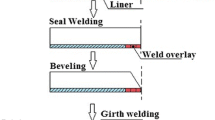Abstract
A theoretical and experimental study of heat flow during the welding of pipes was carried out. The theoretical part of the study involves the development of two finite difference computer models: one for describing steady state, 3-dimensional heat flow during seam welding, the other for describing unsteady state, 3-dimensional heat flow during girth welding. The experimental part of the study, on the other hand, includes: measurement of the thermal response of the pipe with a high speed data acquisition system, determination of the arc efficiency with a calorimeter, and examination of the fusion boundary of the resultant weld. The experimental results were compared with the calculated ones, and the agreement was excellent in the case of seam welding and reasonably good in the case of girth welding. Both the computer models and experiments confirmed that, under a constant heat input and welding speed, the size of the fusion zone remains unchanged in seam welding but continues to increase in girth welding of pipes of small diameters. It is expected that the unsteady state model developed can be used to provide optimum conditions for girth welding, so that uniform weld beads can be obtained and weld defects such as lack of fusion and sagging can be avoided.
Similar content being viewed by others
References
A. Grill:Int. J. Num. Methods in Engr., 1982, vol. 18, p. 1031.
S. Kou and Y. Le:Metall. Trans. A, 1983, vol. 14A, p. 2245.
D. Rosenthal and R.H. Cameron:Trans. ASME, 1947, vol. 69, p. 961.
V. Pavelic, L.R. Tanbakuchi, O.A. Uyehara, and P.S. Myers:Weld. J., 1969, vol. 48, p. 295s.
O.H. Nestor:J. of Appl. Phys., 1962, vol. 33, p. 1638.
C.B. Shaw, Jr.:Weld. J., 1980, vol. 59, p. 121s.
S.V. Patankar:Numerical Heat Transfer and Fluid Flow, McGraw-Hill, New York, NY, 1980, p. 54.
S. Kou:Metall. Trans. A, 1982, vol. 13A, p. 363.
Aluminum Standards and Data, 5th ed., The Aluminum Association, New York, NY, 1976, pp. 38 and 40.
M. Mizuno and H. Nagaoka:Intn. Met. Reviews, Review 240, 1979, no. 2, p. 68.
E.P. Vilkas:Weld. J., 1966, vol. 45, p. 410.
Y. Kuriyamaet al.:IHI Eng. Rev., 1976, no. 4, p. 400.
O. Levenspiel:Chemical Reaction Engineering, 2nd ed., John Wiley and Sons, New York, NY, 1972, chapter 9.
Author information
Authors and Affiliations
Rights and permissions
About this article
Cite this article
Kou, S., Le, Y. Heat Flow during the Autogenous GTA Welding of Pipes. Metall Trans A 15, 1165–1171 (1984). https://doi.org/10.1007/BF02644711
Received:
Published:
Issue Date:
DOI: https://doi.org/10.1007/BF02644711



